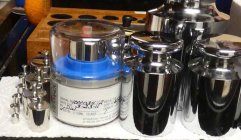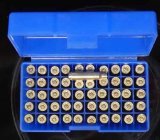redrockranger
Silver $$ Contributor
Why would a beam scale and a digital scale sometimes yield the same results and sometimes not? (Details below; yes, I am going to get a set of fine check weights.)
The 2 scales: I just started brass cartridge handloading. For 16 years prior, I shot a Savage 10ML-II smokeless muzzleloader, which I did with the care appropriate for all handloading, including lots of reading and discussion to understand applicable principles internal and external ballistics. For those 16 years, a Lee 100gn beam scale had enough precision for 60 to 85 grain loads to consistently yield 3/4 MOA groups from my Sav10ML. When I bought the Hornady L&L reloading kit 6 weeks ago, it included a Hornady 500gn digital portable/pocket scale with .1gn precision.
I expect to upgrade to a more precise auto trickler scale down the road, but I want to understand what I observed in the meanwhile.
First batch consistent: For the first 30 cartridges I loaded, I leveled and adjusted/calibrated the Lee balance beam to level at 0.0gns, then verified the Hornady digital scale using the 10g (154.324 gn) checkweight. Next, threw the charges of VV N140 with the Hornady powder measure (also from the kit) about .5 to 1 grain under and placed them them on the Lee beam scale to trickle up to weight (23.5 to 24.5 gn test loads). Lastly, I verified each charge on the Hornady digital scale. The two scales were consistent.
Second batch inconsistent: A few days later, I repeated the same process for 30 more loads. However, this time the two readings on the two scales differed by ~.2 grains on each charge. I zero calibrated the Lee beam multiple times, checked for unevenness under each scale, re-oriented the Lee to make sure hidden bench slope was not the issue, and used the check weight to verify the Hornady scale (it always read 154.3gn). Since the check weight exceeds the Lee weight capacity, and the Hornady checked fine, I assume that the Lee scale was off that day--which I had thought was less likely than a digital scale wandering. In the end, I relied on the Hornady digital scale readings and disregarded the Lee results.
Why? Any thoughts? How or what could cause a beam scale to yield good results one day and erroneous results (even after calibrating) on another day?
Personally. My experience with a Pact Digital and a RCBS 750 digital scale and a RCBS 505 balance beam i went strictly to the RCBS 505. To many variables with the electronic stuff leads to to much double checking and recalibration of the electronics.












